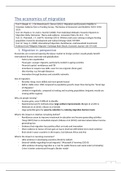The economics of migration
Text 9: Beegle, K., J. De Weerdt and S. Dercon (2011), Migration and Economic Mobility in
Tanzania: Evidence from a Tracking Survey, The Review of Economics and Statistics 93(3): 1010-
1033.
Text 10: Mayda A. M. and G. Facchini (2008), From Individual Attitudes Towards Migrants to
Migration Policy Outcomes: Theory and evidence , Economic Policy 56: 651 – 713.
Text 11: Maystadt, J.-F. and Ph. Verwimp (2014), Winners and Losers among a refugee-hosting
population, Economic development and Cultural Change 62(4):769-809.
Text 12: Yang, D. (2008), International Migration, Remittances, and Household Investment:
Evidence from Philippine Migrants’ Exchange Rate Shocks, Economic Journal 118: 591-630.
1. Migration in perspective
Economists are convinced opening the labour market to foreign workers would greatly benefit
international finance and trade and globalization:
Factor price equalization
Fiscal gain: younger migrants, particularly needed in ageing societies
Financial capital: remittances and FDI
Incentives to acquire new skills, even for non-migrants (brain gain)
Idea sharing, e.g. through diasporas
Innovation through business and scientific networks
Size of migration:
Recently rising; more skilled and more gender-based
Rather stable since 1960 compared to population growth; lower than during the “Great Age
of Migration”
Limited in magnitude, compared to hosting and receiving populations (migrants mostly are
moving within regions)
Why are people moving?
Income gains, even if difficult to identify
Experimental and IV methods show large welfare improvements (Beegle et al (2011),
McKenzie et al (2010), Gibson et al (2010))
Huge potential gains for poverty reduction by reducing migration barriers/costs
What is the impact on relatives remaining behind?
Remittances seem to improve investment in education and income-generating activities
(Yang (2007)) but no immediate impacts (Gibson et al (2011)) and also induce labour income-
generating loss
Evidence that migration has positive effect on trade and innovation
More evidence in favour of brain gain at macro level but still limited micro level evidence
Brain drain in poor countries in the tropics, Sub Saharan Africa and Asia
What is the impact on receiving economies?
Little evidence in developing countries (Strobl & Valfort)
External validity regarding forced migrants? (Maystadt & Verwimp (2014))
Little evidence showing migration as a cost for public finance and social order (criminality).
Crime is better understood through a Becker model
2
, 1. Instrumentalization of migration in Tanzania, Beegle et al
(2011)
Very interesting paper (to be compared with McKenzie et al (2010) or Gibson et al (2011))
Confirms gain improvements (36% in consumption growth)
Confirms that unobservables at household level (selection between households)
correlate with growth potential matter, whereas individual heterogeneity does not
(selection within households)
Instruments not perfectly orthogonal means exclusion restriction is debatable
Even if discussed, cannot deal with sorting. People move to most attractive places
Multiple instruments may ask for just-identified regressions or LIML estimations as
robustness checks (Angrist & Pischke (2009))
New results to be expected
2. Randomization of migration in New Zealand, Gibson et al
(2011)
Very influential paper:
Importance of “between households” selection
Impact of decreased household labour availability is important
In perspective: 25% decrease in income versus 263% increase of migrants!
Limited income pooling
Limits:
External validity (any study) but particularly for education and health of children
Short term analysis: assets may have been used to finance migration, ATM card and income
Based on re-called data and decreasing returns to migration?
3. Refugees, Maystadt & Verwimp (2014)
Impact on labour markets: labour substitutability is key. Competitive natives may suffer
considerable adjustment costs (difficult to distinguish from skill-biased techno change for the
unskilled)
But skill complementarity, surge in demand for goods, and potential boost for trade,
entrepreneurship and innovation explain migration seen as an economic opportunity
Camps: mostly temporary, environmental degradation, disease and weapon spread
4. Beyond the labour market: fiscal net impact and crime
Migrants contribute more in taxes and social contributions than they receive in individual
benefits
Low-educated immigrants net contribution > low-educated native-born
High-educated immigrants net contribution < high-educated native-born
Impact past 50 years in OECD countries on average rarely exceeds 0,5% of GDP
Migrants may be located in less favourable places with high levels of crime
Difficult because crime is also a function of economic opportunities (Becker model)
5. Political economy of migration policy
Destination countries’ governments are not as restrictive as public opinion, due to pressure
of pro-migration interest groups
Firms tend to be a strong force in favour of liberalization of migration flows
2




